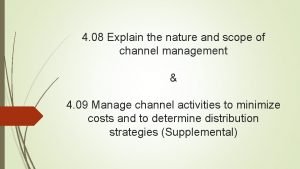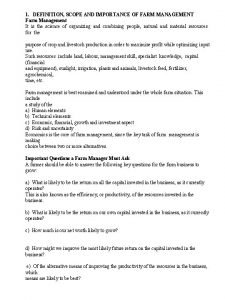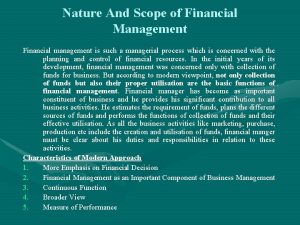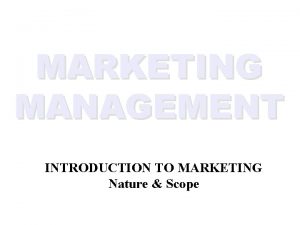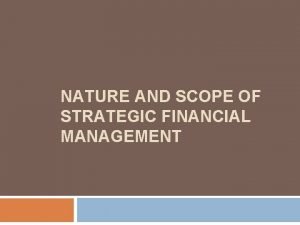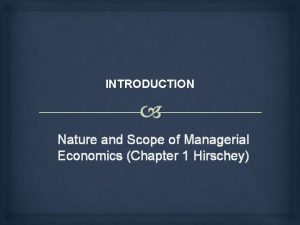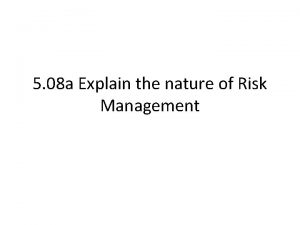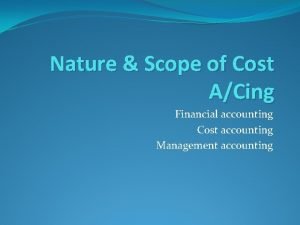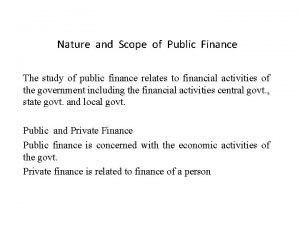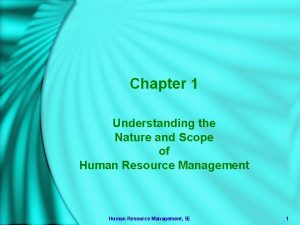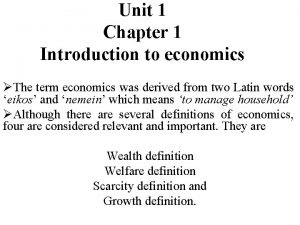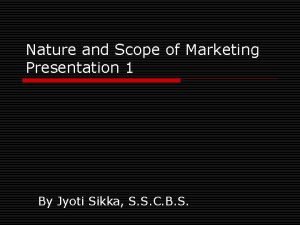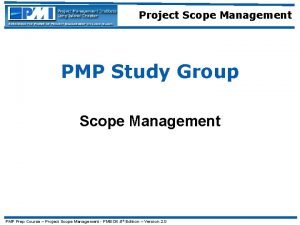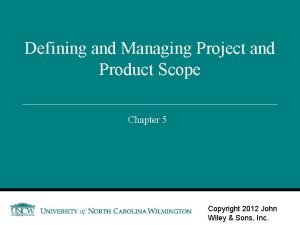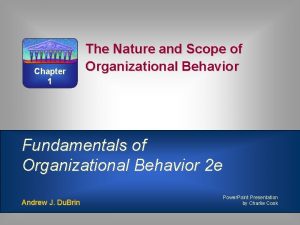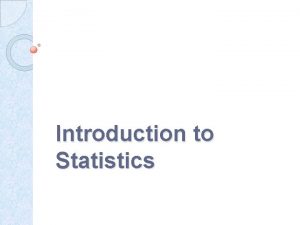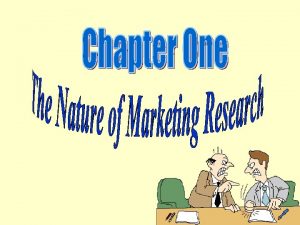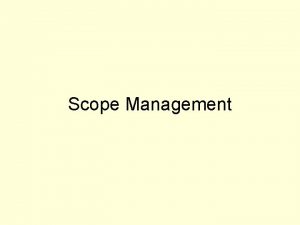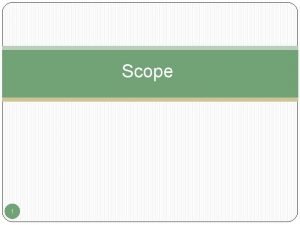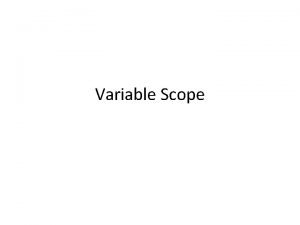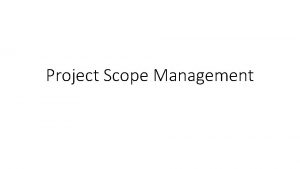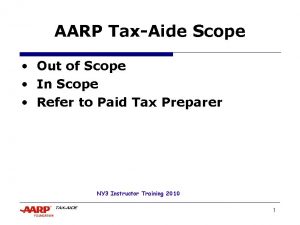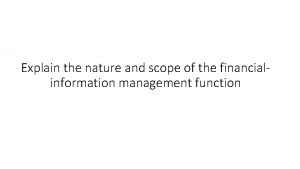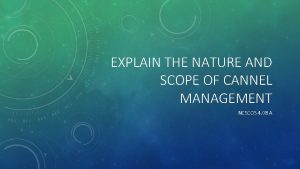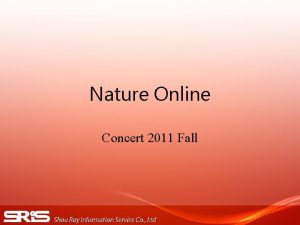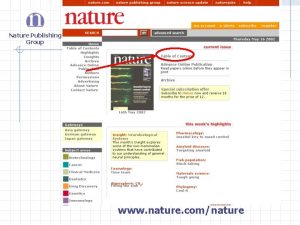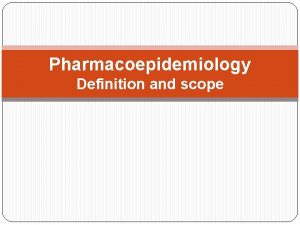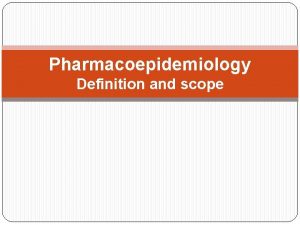4 08 Explain the nature and scope of







































- Slides: 39

4. 08 Explain the nature and scope of channel management & 4. 09 Manage channel activities to minimize costs and to determine distribution strategies (Supplemental)

Vocabulary Channels of Distribution Industrial User Channel Intensity Middlemen Channel Length Intermediaries Distribution Patterns Retailers Exclusive Distribution Wholesalers Selective Distribution Agents Intensive Distribution Direct Channels Producer Indirect Channels Ultimate Consumer

What is channel management? The process of balancing allocation of product inventory and pricing across distribution channels. Who are its members? Channel members are the combination of agencies that the manufacturer markets the product(s)/service(s) to the customer. They are a set of interdependent organizations (intermediaries) that are part of the process to make products and services available to the consumer. The intermediaries in the distribution channel are referred to as “middlemen” and who are specialists in the exchange process by providing access to and control over important resources for the functioning of the marketing channel. How do channel members add value? Business use intermediaries to move their merchandise throughout the country and the world The use of intermediaries results from their greater efficiency in making goods available to target markets Offers the firm more than it can achieve on its own through the intermediaries in order to achieve ideal market exposure.

Intermediaries “Middlemen” And Their Roles Provide goods to customers more efficiently. Are equally committed to the quality of the product or service. Balance supply and demand. Provide: Contacts Experience Specialization Scale of operation

Benefit of Channels of Distribution Enables products and services to easily be obtained from all over the world. Allows producers to get their products to consumers more efficiently.

Direct Channels of Distribution Path that a product takes from producer to consumer. Is the shortest and simplest form of distribution channel. Producer sells a product directly to a consumer without an intermediary and include: Face-to-face sales Computer sales Mail orders Benefits of Direct Channels of Distribution: E-Commerce results in low overhead and increased globalization. Profits are not shared with intermediaries. Disadvantages: Cannot compete with geographical reach and business volume that includes major wholesalers and retailers. Customers are burdened with shipping costs.

Indirect Channels of Distribution There is one or more middlemen between the producer and customer in indirect channels of distribution. There is no direct contact between the producer and the customer. The following are classifications of Indirect Channels of Distribution: Manufacturer Retailer Consumer Manufacturer Wholesaler Retailer Consumer Manufacturer Agent Wholesaler Retailer Consumer Advantage: Indirect channels relieve the producer/manufacturer from the issues of distribution, enabling concentration entirely on producing. Disadvantages: Creates distance between producer and the end user. Producer loses control over distribution. Distribution may be slow due to intermediaries between producer and customer.

Manufacturer Agent Wholesaler Retailer Consumer Longest channel of distribution. Producer sells their entire output to a sole selling agent, who appoints wholesalers. Wholesalers then sell to retailers who sell to the end users (customers). Distribution channel for: Cloth Food grains Sugar Paper

Manufacturer Wholesaler Retailer Consumer Has two types of middlemen (wholesaler and retailer). Consists of “Consumer Products” used daily: Soap Cosmetics Detergents Household cleaners

Manufacturer Retailer Consumer Manufacturer sells goods to consumer via retailers. Has one middleman (the retailer) Consumer durables are generally sold through this channel: TVs Refrigerators Scooters Washing machines Cars Industrial machinery and equipment

What are channel functions? These functions should be assigned to the channel member who can add the most value for the cost: • Information • Promotion • Contact • Matching • Negotiation • Physical Distribution • Financing • Risk Taking

• Information Intermediaries research the market to gather information necessary for planning and facilitating the exchange of goods and services. Information gathered and provided include: Changes in customer demographics Changes in customer psychographics Changes in customers media habits New competitors entering the market New brands Changes in customer preferences

• Promotion Intermediaries promote product(s) in their territory by designing their own sales incentive programs with a goal to gain customers.

• Contact Intermediaries search out and communicate to prospective buyers.

• Matching Important activity performed by intermediaries that involves matching the needs of buyers and sellers. Example: An artist may not know where or how to reach potential customers; however, an art dealer would know. The matching process includes: Contractual – finding buyers and sellers Merchandising – Producing goods/services to satisfy customer demand Pricing – Placing monetary value to the product/service Propaganda – Activities involving sales promotion Physical Distribution – Activities involving distribution Termination – Settling the contract

• Negotiation Intermediaries facilitate the final agreement on pricing and other terms in order to transfer ownership or possession of the goods/services.

• Physical Distribution Physical distribution refers to the actual physical flow of products. Effective physical distribution management requires attention to the five (5) interrelated activities: Order processing – procedures for receiving, handling & filling orders. Inventory control – satisfying order-fulfillment of customers while minimizing the investment and fluctuations in inventory. Inventory location and warehousing – provides functions such as: assembly, dividing, storing, and preparing products for reshipping. Materials handling – equipment to physically handle products (i. e. , warehouse building and equipment used to minimize losses from breakage, spoilage, and theft. Transportation: Mode – railroads, trucks, pipelines, water vessels, and airplanes. Particular carrier(s)

• Financing Acquisition and distribution of funds to cover the costs of the channel services.

• Risk Taking Intermediaries assume the risks in connection with carrying out channel work.

Channel market tasks Various channel tasks are handled by different groups according to their ability to perform the task best: Manufacturer Marketing Packaging Financing Wholesaler Storage Delivery Retailer Merchandising Personal Selling

What is the difference between horizontal and vertical conflict? Horizontal Conflict Occurs among firms at the same level of the channel (ex. Retailer to retailer) Vertical Conflict Occurs between different levels of the same channel (ex. Wholesaler to retailer)

6 Factors to consider when selecting a channel of distribution 1. Nature of the product (physical characteristics): Perishability – Risk of compromising quality if the channel of distribution is not shorter. Size and Weight – Transportation can be costly, so shorter and direct channels should be considered. Unit value of a product – Products with lesser unit value and higher turnover can be distributed by longer channels (ex: household products, food, etc. ); however, more valuable products can be sold directly to the customer (ex: jewelry, automobiles, etc. ) Standardization – standards size and quality products take longer channels of distribution (ex: automobiles, machinery, etc. ). Non-standard products take lesser time and use shorter channels of distribution. Technical Nature of Products – Highly technical, industrial products are distributed directly to the industrial users (shorter channel), while consumer technical products sold through retailers and wholesalers (longer channels) consists of: televisions, refrigerators, etc. Product Lines – Products in the same product lines selling directly or through retailers (shorter channel), while manufacturers selling one product will appoint a “sole” selling agent, (longer channel).

6 Factors to consider when selecting a channel of distribution cont… 2. Nature of the market: Consumer of industrial market – when number of buyers are less, so a shorter channel is selected. When the number of buyers are larger, a longer channel is selected. Size of the order – Direct selling takes place when the order size is large, but “intermediaries” distribute products when the size of the order is small. Geographic concentration of market – when customers are concentrated in a particular place, manufacturers can sell directly by opening shops or sales depots (shorter distribution); however, when customers are scattered, services of wholesalers and retailers are used. Buying habits of customers – customer tastes and preferences.

6 Factors to consider when selecting a channel of distribution cont… 3. Nature of the middlemen “intermediaries: ” Cost of distribution of goods – Higher cost of distribution will result in higher cost of the product. Availability of desired middlemen – Lack of middleman availability may result in the manufacturer making other arrangements to distribute goods to the consumer (i. e. , opening branches or sales depots). Policies – Terms and conditions may not favor the middleman (i. e. , some middlemen may prefer to be the sole selling agent for a particular product). Services provided by middlemen – Manufacturers select middlemen who provide various services, while ensuring various services to customers (i. e. , storage, parking, credit, etc. ) Ensuring greater volume of sales – selecting middlemen who assure greater sales volume. Reputation and financial soundness – Financial stability and reputation of a middleman is important as to ensure credit is available to customers and prompt payment is made to the manufacturer.

6 Factors to consider when selecting a channel of distribution cont… 4. Nature and size of the manufacturing unit: Manufacturer reputation and financial stability – Financially weaker manufacturers cannot operate without the help of middlemen. Ability and experience of the undertaking – Marketing units possessing lesser marketing ability and experience depend more on middlemen. Desire for control of channel – Shorter distribution channels may be selected in order to have more control over distribution (i. e. , perishable goods). Industrial conventions – If a particular mode of distribution is adopted in an industry, the same will be followed by every manufacturing unit in that industry. Services provided by the manufacturers – Extensive advertisement, after sales services and facilities of credit.

6 Factors to consider when selecting a channel of distribution cont… 5. Government regulations and policies: Government may impose certain restrictions on the wholesale trade of a particular product, which will have a direct impact on selecting a channel of distribution. 6. Competition: Different manufacturers producing similar products may employ the same channels of distribution.

Channel management decisions 1. Setting channel objectives. 2. Selecting Channel Members Identify characteristics that distinguish the best channel members 3. Managing and Motivating Channel Members Partner relationship management (PRM) is key 4. Evaluating Channel Members Performance should be checked against standards

Channel Design Decisions 1. Analyze Consumer Needs 2. Determining Channel Objectives 3. Identify and evaluating the major channel alternatives

1. Analyze Customer Needs When designing marketing channels, marketers must understand output levels of the customer. There are five (5) service outputs: Lot size – number of units a customer is permitted to purchase at one time. Waiting Time – Average time customers wait for receipts of products. Spatial Convenience – How easy is it for a customer to purchase the product. Product Variety – Assortment breadth provided by the marketing channel. Service Backup – Add-on services provided by the channel (credit, delivery, installation, repairs, etc. )

2. Determining Channel Objectives State objectives in terms of targeted output levels. Arrange functional tasks to minimize costs with desired levels of output. Objectives vary with product characteristics.

3. Identify and Evaluate Major Channel Alternatives After determining channel objectives, the company should identify its major channel alternatives in terms of: Types of intermediaries, The number of intermediaries needed, and Terms and responsibilities of each channel member.

Types of Intermediaries Distributor – Similar to wholesalers, but only carry a complementary product line (i. e. , Coke products or Pepsi products); however, wholesalers carry a variety of competing products (i. e. , Pepsi, Coke, etc. ). Maintain close relationships with customers and suppliers. Will take title to products and store them until sold. Retailers – Takes title or purchases products from other intermediaries. Can be independently owned and operated (i. e. , small stores or large chains). Sell products it has purchased directly to the end user for a profit.

Types of Intermediaries cont… Agent – Independent individual or company whose function is to act as the seller for the producer, and represent the producer to the customer. An agent takes possession of products, but does not own them. Agents make profits from commissions or fees paid for their services. Wholesaler – Independently owned firms that takes title to the product it handles and then distributes products to retailers, other distributors, or sometimes the end users. Wholesalers own the products they sell. Wholesalers purchase products in bulk and store it for resell. Wholesalers sell products they purchased to other intermediaries (usually retailers) for a profit.

Numbers of Intermediaries Needed Businesses will need to decide on the number of intermediaries to use based on the following three (3) strategies: Exclusive Distribution – Used when the producer wants to maintain control over the service level and outputs offered by the resellers. Usually involves an exclusive dealing arrangement (resellers agree not to carry competitions brands). Selective Distribution – Appropriate for shopping products, which involve customers shopping around to compare prices, designs, styles and features. Intensive Distribution – Appropriate for convenience products (soft drinks, bread, candy, newspapers, etc. ) that have high replacement rates and require almost no service. Multiple channels are used (convenience stores, service stations, supermarkets, etc. ).

Terms and Responsibilities of Each Channel Member Channel members must be given the same opportunity to make a profit based on the following elements: Price policy – includes price lists and a schedule of discount and allowances. Conditions of sale – Producer guarantees and payment terms. Distributors territorial rights – Distributors territories and terms that the producer will enfranchise to other distributors. Mutual services and responsibilities – For franchises in which franchiser provides promotional support, training, system for keeping records, etc.


Channel management in a nut shell The customer is the puzzle. You need to work with people to put the puzzle together to give the customer what they want.

Day 1 = Assignment #1: Presentation Guided Notes Day 2 = Assignment #2: Video How Coca Cola Produced & Distributed Around the World & 4. 08 Video Guided Notes (Note: Teacher will show video and provide handout)

References http: //www. slideshare. net/rajworship/distribution-channels http: //www. yourarticlelibrary. com/marketing/10 -most-important-functions-ofmarketing-channel/5784/ http: //www. yourarticlelibrary. com/stores/channel-of-distribution-6 -factors-toconsider-while-selecting-a-channel-of-distribution/25909/ http: //www. slideshare. net/rozianaaliman/chapter-4 -designing-marketing-channels http: //www. preservearticles. com/2012022923847/what-are-the-indirect-channels-of -distribution. html
 Scope of educational psychology:
Scope of educational psychology: Scope of channel management
Scope of channel management Explain the nature and scope of channel management
Explain the nature and scope of channel management Nature and scope of farm management slideshare
Nature and scope of farm management slideshare Scope of financial management
Scope of financial management Explain the nature and scope of marketing
Explain the nature and scope of marketing Scope of physics
Scope of physics What is marketing nature scope and importance
What is marketing nature scope and importance Nature and scope of managerial economics
Nature and scope of managerial economics Social work meaning
Social work meaning What is the nature of risk
What is the nature of risk Nature of clinical psychology
Nature of clinical psychology Scope of public administration
Scope of public administration Scope of strategic management accounting
Scope of strategic management accounting Nature of managerial accounting
Nature of managerial accounting Nature and scope of managerial economics
Nature and scope of managerial economics Nature of risk meaning
Nature of risk meaning Scope of cost accounting
Scope of cost accounting Public finance nature
Public finance nature What is industrial sociology
What is industrial sociology Explain the scope of ob
Explain the scope of ob Nature and scope of hrm
Nature and scope of hrm Nature and scope of physics
Nature and scope of physics Scope and importance of economics
Scope and importance of economics Nature of educational sociology
Nature of educational sociology Nature and scope of marketing management
Nature and scope of marketing management Introspection method
Introspection method History and scope of pharmacognosy
History and scope of pharmacognosy Product scope vs project scope
Product scope vs project scope Product scope vs project scope
Product scope vs project scope Nature and nature's laws lay hid in night meaning
Nature and nature's laws lay hid in night meaning Scope of multidisciplinary nature of environmental studies
Scope of multidisciplinary nature of environmental studies Explain the scope of ob
Explain the scope of ob Statistics refers to
Statistics refers to Determinace lidské psychiky
Determinace lidské psychiky Marketing research is in nature
Marketing research is in nature What is the measure of
What is the measure of Hát kết hợp bộ gõ cơ thể
Hát kết hợp bộ gõ cơ thể Bổ thể
Bổ thể


